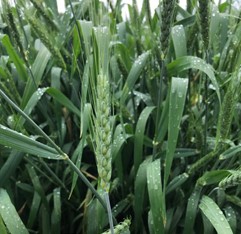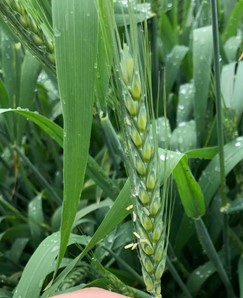Joanna Follings and Albert Tenuta
With the exception of powdery mildew in susceptible varieties, disease pressure in winter wheat has been found at low levels. With persistent dry conditions continuing, many are asking if a T3 fungicide application should be made. Below are some key considerations when making a T3 fungicide application decision.
Is the field at risk of an FHB infection?
Winter wheat is most susceptible to FHB infection during the flowering period. Spores are carried from infected crop residue by wind or rain and splash onto the wheat head. Rainfall or heavy dew during this period then causes the spores to germinate and infect florets on the wheat head. In order for the spores to germinate and infect, there needs to be rainfall or high humidity for at least 12 hours. The disease is also most likely to occur when temperatures are between 15 to 30 C with the optimum temperatures being 25 C. Given the continued persistent dry conditions in many areas and temperatures above 25C, the risk for FHB infection is currently very low.
If your wheat crop was planted after corn or wheat and you are growing a susceptible variety, your risk of FHB infection is greater and a preventative fungicide application is recommended. To determine the susceptibility of a variety please visit www.GoCereals.ca under the performance tab.
What are the average yield responses to a T3 fungicide?
Ontario growers have been able to effectively manage FHB with T3 fungicide applications. In research led by Dr. Dave Hooker, U of G Ridgetown Campus, a response to a T3 fungicide application greater than 5.5 bu/ac was achieved 75% of the time. On average the response to a T3 fungicide is 8 bu/ac. However, given the continued persistent dry conditions in many areas as wheat heads begin to emerge, and the low risk for FHB infection, it is important to assess the application costs with the yield potential and value of the crop you are dealing with. This includes considering the yield losses due to tramlines, custom applicator costs and the costs of the product itself.
What if there is powdery mildew in the field?
Powdery mildew continues to be reported at moderate levels in a number of fields, specifically those with susceptible varieties. To determine a varieties level of tolerance to powdery mildew refer to the Head to Head feature on Ontario Cereal Crop Committee (OCCC) website. Simply select the area the field is located in, the variety being grown and powdery mildew. It will provide a rating score from 0 to 9. The higher the score, the more susceptible the variety is to powdery mildew and may require a fungicide application.
What are the risks of not applying a T3 fungicide?
While we can’t predict the weather beyond 2 weeks out, the current forecast remains conducive for low FHB risk during this critical pollination period. Disease pressure also continues to remain low; therefore, it is anticipated that disease pressure will continue to remain low in the coming weeks. If wet, humid conditions return, it will be important to continue to monitor your crop for any signs of disease. Planning for a timely harvest will also reduce the amount of fusarium that continues to grow particularly when moisture levels are high (>19%).
If the risk for FHB is greater or other diseases are present, when should a preventative fungicide be applied?
Once 75% of the heads on the main stem reach GS59 (head emergence complete) this is known as “day 0” (figure 1). The optimum fungicide application timing is shortly after this on “day 2”. Day 2 is the beginning of pollination when anthers are visible on the middle of the wheat head (figure 2). This timing is critical because this is when the peak number of florets are open and susceptible to infection. If temperatures are warm during this period it could result in the wheat crop moving quickly through these growth stages so it will be important to track the staging of your wheat crop as it approaches heading (GS59).

While day 2 is the optimum time, T3 fungicides can be applied up to day 6-8 with good efficacy. Therefore, waiting an extra day or two and targeting day 3-8 may allow you to widen the window of protection especially under these conditions. Two fungicide applications are not recommended as they are generally not economical, particularly in those fields with low yield potential and again under these dry conditions.

Which fungicides should be applied at T3?
While there are a number of fungicides available for disease control in winter wheat, there are only few that can be applied at the T3 fungicide timing. Metconazole, prothioconazole and pydiflumetofen three active ingredients which have been most consistent in suppression of FHB. All other fungicides do not provide adequate or consistent protection against FHB.
Additionally, it is important to avoid applying any fungicides from the strobilurin class of fungicides as these have been shown to increase DON levels in winter wheat when applied at the T3 timing.
What about two applications? Two fungicide applications at heading is generally not economical, particularly in those fields with lower yield potential. It is also important to follow the label for pre-harvest interval restrictions.
What else should be considered before a T3 application?
Before getting out to the field to spray your wheat, ensure your sprayer has been adequately cleaned, you are using the appropriate nozzles (i.e., such as forward-and-back double nozzles or alternating turbo floodjets) and adequate water volumes (18-20 gallons/acre).

Sources:
Crop Protection Network – Fusarium Head Blight
